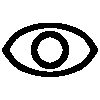Colors are everywhere around us: Advertizing, images, videos, TV, products. They all try to attract our attention by beautiful colors.
Colors can improve mood. The first time I noticed power of colors when I painted my bedroom from darker color into some shade of pale yellow. The next morning it was invigorating when I woke up with walls bright and nicely painted. Also it is pleasure to visit nicely decorated stores such as store with Mexican decorative products with lot of bright colors. It feels like being in a candy store.
When I started with art photography I did not know colors may have significant impact in image creation. My understanding was to get colors from the camera, increase saturation if appropriate, and that was it. It turned out things were not so simple. I was introduced to color theory where every color has a mood and corresponding feelings. This was more than I was hoping for.
My wife learned about colors by matching her clothing and makeup. Later she worked in retail and needed color knowledge to organize a shop window. I wear a pair of blue jeans, gray shirt and no makeup. So, what about me? I had to study some dry books on color theory.
Have you seen the color wheel? It is a nice colorful picture. Can you imagine somebody writes an entire book only about this picture? Well it is already written, it is called color theory.
I thought the brightness of the same color is constantly bright regardless of its surrounding. On my big surprise I realized our eyes do not see colors in absolute way. For example, the same shade of yellow will look brighter beside blue than beside white. These phenomena used to get me scratching my head. It is hard to believe but it is true.
Have you heard about Gestalt effect? In simple terms, when you have ¾ of a circle our eyes tend to fix this problem and send signal to the brain about a whole circle. It is much easier to simplify things than to think where the heck ¼ of the circle went missing. Most of the time, this happens subconsciously. The reason to tell you about this is our eyes do the similar thing with colors. For example, imagine field of dandelions and grass in ratio 80/20. Since yellow is more dominant color, we assume this field is yellow. The same happens if grass is dominant and we assume field is green. What happens when ratio is 50/50? We need to wake up and pay more attention. The colors start to vibrate. At one point the field looks green while on the second look it looks yellow. Guess what? People who know colors use this effect to force us to pay attention to their work.
At first the theory was abstract and could not apply anything to reality. Eventually things started to come together. In simple words there are 7 color contrasts. In order to apply color theory in my work I needed to apply one or more of these contrasts. Sort of to find the contrast and colors that fit the picture and my style of crating images.
Color Manipulations
1. Colors can be manipulated before a picture is taken. For example, during summer vegetation is green. If I found some red flowers this would create nice red-green complementary contrast. On the other hand I can come in fall to the same location when grass is yellow-orange. Now I can use yellow-dark blue complementary contrast if I capture some blue sky.
2. You can manipulate the amount of area that each color takes. For example you have open landscape with a bunch of dandelions in front of you. If you take image standing up yellow color of the flowers will take 1% of your image. Now you get down closer to dandelions and take another image. Now yellow color of the flowers takes 10-20% of the area of your picture.
3. Colors can be manipulated in post processing by adjusting hue, saturation and brightness. As well as, an area of the picture can be replaced with different color.
The picture bellow shows a raw camera image on the left and the processed image on the right. I applied the complementary contrast of yellow and dark blue. I processed this image long time ago, today I feel I needed to apply additional color contrast. The theory says dark blue and yellow should be in ratio 3:1. So I think I have too much yellow in this picture. This is one example how color theory is applied in landscape photography.

Some people may prefer the first image. At the end of the day we all have different tastes. The point I try to make is the second image attract much more attention while the first one is more subtle. The loud color contrasts will attract attention but will not keep interest of the viewer for very long. On the other hand, a subtle color contrast may not be noticed. A viewer just walks by without noticing.
As a result, application of color theory requires certain amount of artistic talent, to select a color contrast in a way that viewers find colors soothing. This requires knowledge of color theory, your audience, and occasion. Obviously if you want to apply color theory you need to know the color contrasts. Mountain people like their landscapes, horse people like their horses, city folks like their black and whites. If you do an advertising image, you need to create loud contrast to be noticeable while fine art image will require a subtle color contrast.
View My ImagesBlog HomeHome Page













